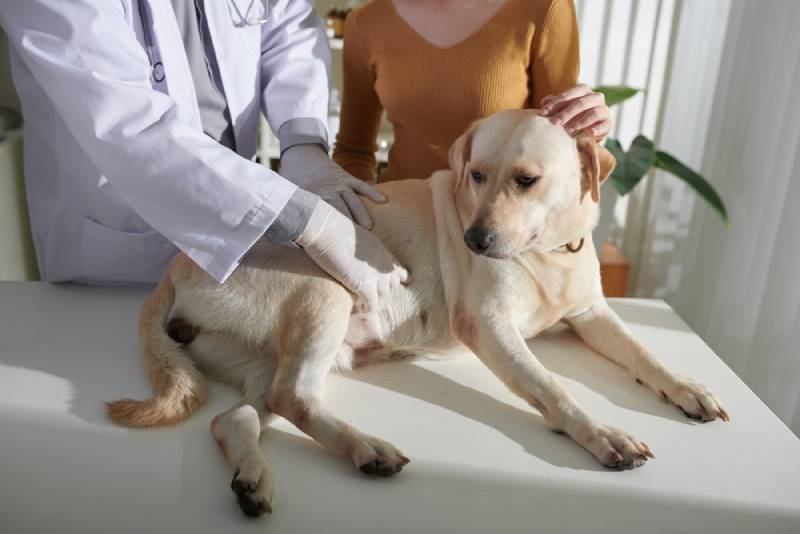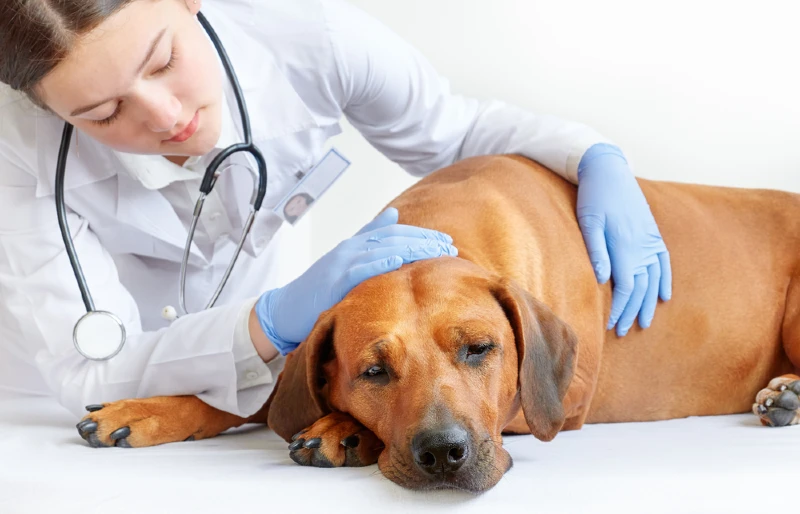Why Did My Dog Throw Up? 6 Vet Reviewed Reasons
By Ashley Bates
Updated on

Our dogs are often getting into things that they shouldn’t eat. From garbage to sirloin, dogs will eat anything they can get their grubby paws on—except that new kibble you paid darn good money for.
So, when your dog starts vomiting, you might immediately jump to the conclusion it had something that didn’t sit right with its stomach. In some cases, that’s probably true.
But here, we will discuss the difference between actual vomit and regurgitation and all of the underlying triggers we can think of. Let’s uncover the issue.
Top 6 Reasons Dogs Throw Up
1. Fast Eating
| Type: | Regurgitation |
Some of our dogs can be real pigs. We all know it. It seems that anytime you drop something off of a plate or rattle a bag, here they come running.
If your dog has an issue with eating really quickly, that can cause them to spill the contents of their last meal. While this might seem like vomiting, it’s actually called regurgitation. That’s when the stomach empties its contents directly after eating, becoming too full too quickly.
If you know that your dog is frequently regurgitating after eating, it could be a sign that they need to slow it down. Luckily, tons of products on the market can help regulate your dog’s meal consumption speeds.
On sites like Chewy, you can find slow feeders and tilted bowls that help your dog ration and slow their eating.

2. Lodged Object
| Type: | Vomiting |
If something gets trapped anywhere between your dog’s mouth and intestines, they can vomit and attempt to dislodge whatever it might be.
Whether it’s a bone, toy, or a stick they picked up from the yard, vomiting is there a way of projecting the object out of the body. Consider it a natural defense, the same way it would be if it were humans.
Sometimes vomiting does not release the lodged object, however. If it seems like your dog is still struggling to get something else with or without vomit present, getting them to your veterinarian is time-sensitive and crucial.
While some objects are easily removed, others can require surgery. Removal can be quite dangerous depending on the sharpness and material ingested, so don’t delay.
3. General Nausea
| Type: | Vomiting |
Sometimes, your dog just might not be feeling very well. Whether it was their own food that wasn’t sitting right with their belly that day or they’re just feeling under the weather, sometimes vomiting can come and go with no further evidence of a problem.
If your pup just seems like they’re under the weather one day and they vomit once or twice, it really shouldn’t raise too much concern. However, if this is a repeating or recurring theme, you want to get to the bottom of it.
Otherwise, understand that our pups are just as likely to feel unwell occasionally–just as their human counterparts.
4. Underlying Illness
| Type: | Regurgitation/vomit |
So many illnesses can have vomiting as a symptom. It would be impossible to pinpoint an exact underlying disease from the symptom of vomiting alone. Because of that, it is important to note other signs that could be related to vomiting. Some of the most common, we will touch on here.
Vomiting can result from a problem with just about any bodily system, but the most common (along with other symptoms) are:
- Pancreatitis—nausea, vomiting, fever, lethargy, abdominal pain, loss of appetite
- Kidney Disease –dehydration, weight loss, weakness, diarrhea, excessive thirst
- Liver Disease—anorexia, weight loss, weight loss, jaundice
- Cancer—lumps, sores, changes in bathroom habits, difficulty eliminating, loss of appetite
These types of problems are less common, but you shouldn’t disregard the possibility of your pup continually getting sick. Plus, your dog will experience dehydration and nutrient loss with frequent vomiting.
Since so many illnesses share overlapping symptoms, further examination is required. While ultimately it’s up to your vet, they will generally run some basic blood in urine samples and more advanced testing, if needed.

5. Garbage Gut
| Type: | Vomiting |
Is your dog a little trash digger? Garbage gut is a term coined to describe dogs who get sick scavenging. Some dogs are much more prone to eating disgusting things than others. You might not be able to get your Maltese to eat expensive dog food, but your Pitbull will scarf down something before they even smell it.
It just depends on the individual dog. However, if you have a scavenger who loves to sniff out carrion, trash, old food, and other unmentionables, they can have all sorts of intestinal troubles. There’s really no need to explain here why this could cause problems with the vomiting.
However, it’s really something you need to keep your eye on. Dogs can pick up all sorts of illnesses from contaminated items. Additionally, scavenging can consume non-food items that can make your dog very sick or unable to digest the material.
You could wind up with vet bills a mile long—so make sure to keep your little dumpster diver in check to avoid serious complications—like emergency surgery.
6. Food Allergies
| Type: | Vomiting |
If your dog has a food allergy of some sort, vomiting can be a sign something isn’t right. It’s almost always accompanied by other classic symptoms, though it doesn’t have to be in every scenario.
The most common food allergies in dogs include protein and dairy allergies—though many more can exist. Grain allergies are also semi-common—but not as much as some marketing companies would lead you to believe.
- Skin infections
- Weight loss
- Vomiting/diarrhea
- Inflamed skin
- Lethargy
- Nasal drainage
- Excessive itching
- Excessive grooming
If these things seem to ring a bell, it might be time to make an appointment. If you suspect food allergies but you haven’t yet spoken with your veterinarian, be sure to go over any concerns you might have. Your vet can get blood and urine samples to learn a little more about how their body is operating.
Your vet will most likely put your dog on food trials to see the potential trigger. Once you get to the root of the problem, you can choose a dog food that doesn’t irritate their system.
Luckily, there are tons of ways to combat food allergies for your dog nowadays. Commercial diets on the market cater to pets of every sensitivity. Plus, you can try to make your dog their very own homemade food.
If you plan on feeding your dog a homemade diet, make sure to run the recipe you’re using by your veterinarian to make sure you’re meeting all nutritional requirements.

Vomiting vs Regurgitation: What’s the Difference?
We often think of regurgitation and vomiting as the same thing. That’s simply not correct. Vomiting and regurgitation or not simultaneous things, but they come from different underlying factors and consistencies.
Vomiting is a forced ejection from the stomach where food is mostly digested. Often vomit has a very foul odor and liquid texture. Whereas regurgitation is likely to be whole and partially digested food, you might be able to see your dog’s food. Regurgitation happens quickly after eating, whereas vomit can occur several hours later.
Color Matters
If your dog vomited, the color of the contents could tell you quite a bit. Keep in mind, that this is a general guideline. You will need to see a professional to rule out any other illnesses or contributing factors.
| Yellow | Empty stomach |
| Brown | Intestinal blockage |
| Green | Eating plant material, bile |
| Foamy, White | Pancreatitis, kidney problems, bloat, inability to digest object |
| Black | Often signals blood in digestive tract |
| Red | blood |
Watch Behaviors
Especially if your dog regurgitates, this is most likely a passing phase. But if you notice other symptoms that accompany vomiting, you must get them to your veterinarian for further evaluation.
Vomiting, in some cases, can be expected. After all, our dogs can get an upset stomach from eating the wrong thing just like we can. But there’s a difference between mild stomach upset and a real problem.
Underlying illnesses don’t have to be incredibly damaging. It could trigger the sign of something as simple as a food allergy. Keep track of any change in your cat’s daily functioning.
Dehydration is a real thing. If your dog can’t keep down fluids, it can get very dehydrated, which can be very dangerous.
When to See the Vet
If you sense something is wrong, get your dog to the vet as quickly as you can get them there. If it’s easy to pinpoint the problem and there’s a quick solution, you probably won’t have to see your vet. However, if vomiting is just one of the many ongoing symptoms your dog is showing, it’s best to make them an appointment. Also, if your dog is in a state of emergency, never wait.

Final Thoughts
Vomiting can be pretty concerning, especially if it happens regularly. If ever you suspect your dog is extremely ill, remedying the situation is most important. Use your intuition, and if you think they need to see the vet, get them there right away.
Also, if you think your dog might’ve eaten a potentially toxic substance but you’re unfamiliar with it, you can also use the pet poison control hotline to help you.
Featured Image Credit: Dragon Images, Shutterstock













